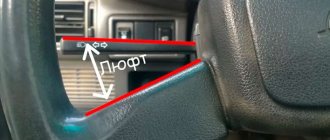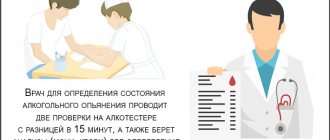Administrative liability is provided for failure to comply with the traffic rules of the Russian Federation. The law allows representatives of the State Traffic Inspectorate to remove a driver from driving a vehicle. This is one of the methods of administrative punishment. After being suspended from driving, a person will not be able to drive until the reason that led to the application of the measure is eliminated.
The grounds for removal from driving a vehicle are recorded in a resolution drawn up by traffic police officers. A person can be suspended from driving only in compliance with established standards.
What is a driving suspension?
The definition of the concept follows from the provisions of Article 27.12 of the Code of Administrative Offenses of the Russian Federation. Removal from driving a vehicle is a punishment for committing a number of administrative offenses, entailing temporary deprivation of the right to drive a car. The restriction can be imposed on the driver of any vehicle:
Attention! If you have any questions, you can chat for free with a lawyer at the bottom of the screen or call Moscow; Saint Petersburg; Free call for all of Russia.
- passenger car or truck;
- river boat;
- bus;
- tram;
- other vehicles.
Removal from driving is carried out to prevent more serious administrative offenses that could result from continued driving. A traffic police officer or other person monitoring compliance with Russian Federation traffic regulations has the right to apply punishment. The measure is temporary. Once the violation is corrected, access to driving will be restored.
What does removal from management mean?
The legislation of 2021 contains a number of procedural actions that in one way or another encroach on the rights and freedoms of Russian citizens. Previously, we have already discussed the search and inspection of the car, the examination for intoxication, and evacuation to the impound lot.
As a rule, all such procedures have a clear definition of what they mean and what they are all about. However, you will not find any definition in the legislation about removal from the right to drive vehicles (hereinafter referred to as “vehicles”). However, is it necessary given the maximum clarity of the term itself?..
Essentially, removal from driving a vehicle means continuing to operate the vehicle for its intended purpose. That is, the traffic police officer requires you to stop driving the car and not operate the controls.
What does it mean? Are you required to get out of the car in this case? Logically, no. According to the practice of law, you can be held accountable for this under Article 19.3, Part 1 for failure to comply with the legal request of a police officer.
Are you required to give your car keys to a traffic police officer? Not according to the law either. But the inspector also has the right in this case to demand the keys, depending on the very purpose of the removal. One of them could be using your car to drive it. But this reason is also not always legal - we’ll talk about that!
Grounds and reasons
The list of grounds for applying suspension from driving a vehicle is given in Article 27.12 of the Code of Administrative Offenses of the Russian Federation. Punishment will be imposed on the offender in the following situations:
- The car is driven by a citizen who was previously deprived of the right to drive a car, and the deadline for returning the license has not yet arrived (Article 12.7 of the Code of Administrative Offenses of the Russian Federation).
- The representative of the State Traffic Inspectorate has reason to believe that the person is intoxicated. Moreover, it does not matter whether it is narcotic or alcoholic (Articles 12.8 and 12.26 of the Code of Administrative Offenses of the Russian Federation). The citizen will be asked to undergo a medical examination.
- A person operates a vehicle knowing that the brakes, clutch or steering are defective. This leads to danger for the owner of the car and other road users (Article 12.5 of the Code of Administrative Offenses of the Russian Federation).
- The citizen does not have a complete list of documentation with him, which must be in the car (Article 12.3 of the Code of Administrative Offenses of the Russian Federation). The list of required papers is presented in clause 2.1.1 of the Russian Traffic Regulations.
- The car is driven by a person who does not have a license (Article 12.7 of the Code of Administrative Offenses of the Russian Federation).
If a representative of the State Traffic Inspectorate suspects that the driver is drunk, the citizen is removed from driving the car and sent for examination. The reasons for making such a decision are:
- presence of the smell of alcohol;
- postural instability or inability to maintain an upright position;
- behavior inappropriate to the situation;
- the color of the skin is changed;
- impaired clarity of speech.
Continuing to drive in this condition may result in a serious accident. Therefore, even the most insignificant sign is taken into account.
The removal is carried out in the presence of two witnesses. If it was not possible to involve them in the proceedings, video recording is made. It is mandatory to draw up a protocol on removal from driving a car.
The examination is carried out in accordance with the standards of the Government of the Russian Federation No. 475 of June 26, 2008 and clauses 227-232 of the Administrative Regulations of the State Traffic Safety Inspectorate. Before the procedure begins, the traffic police officer must explain what he plans to do, as well as demonstrate the measuring device, presenting documents for it and showing that the stamp is intact.
Then measurements are made taking into account the instrument error. Based on the results of the procedure, an inspection report is drawn up. The document must be signed by witnesses, if present, the inspector and the driver.
If the driver does not agree with the results obtained, he may request an examination at a medical institution, where a traffic police representative must take the citizen. If intoxication is confirmed, the car will be taken to the impound lot. The exception is when there is someone to replace the driver. A citizen who has a license and is included in the MTPL insurance can take control of the car. In this case, the car will not be taken away.
If the examination does not confirm the fact of intoxication, the driver will be able to continue driving. A representative of the State Traffic Inspectorate is obliged to deliver the person to the place where the car was left.
Normative base
Representatives of the State Traffic Inspectorate are guided by the provisions of the Traffic Regulations of the Russian Federation and Federal Law No. 196 of December 10, 1995 “On Road Safety”. If the rules enshrined in the above regulations are violated, punishment is imposed. The possibility of removing a driver from driving a vehicle is provided for in Article 27.12 of the Code of Administrative Offenses of the Russian Federation.
The conditions under which it is permissible to remove a driver from driving a vehicle are reflected in the following chapters of the Code of Administrative Offenses of the Russian Federation:
- ;
- ;
- ;
- ;
- .
Removal from driving a vehicle without witnesses
Witnesses act as witnesses. They must confirm that the procedure was carried out in accordance with the Regulations. However, removal from driving a vehicle is possible if video recording is carried out (Article 27.12 of the Code of Administrative Offenses of the Russian Federation). In this case, State Traffic Inspectorate employees are required to act according to the standard scheme. They must prepare a report, present the document to the offender, and then seize the vehicle. A recording is required to prove that all regulations have been followed. The video will certainly be viewed during the trial, if one is held.
Procedure for removal from driving a vehicle
The process of removal from driving a car is carried out in accordance with the norms of clauses 223-226 of the Administrative Regulations, approved by Order of the Ministry of Internal Affairs of the Russian Federation No. 664 of August 23, 2021.
If grounds have been identified that allow the measure to be applied, a representative of the State Traffic Inspectorate will draw up a protocol. The document is drawn up in the presence of two witnesses - disinterested persons involved to certify the procedure being carried out. The person playing this role must be of legal age. Only uninterested persons can act as witnesses. Their participation is recorded in the minutes. If the case comes to trial, the witness may be questioned as a witness (Article 25.7 of the Code of Administrative Offenses of the Russian Federation). If there are no witnesses, video recording is allowed (Article 27.12 of the Code of Administrative Offenses of the Russian Federation).
The protocol contains the following information:
- stopping place;
- date and time of detention;
- personal information of the driver and traffic police officer;
- reason for removal from management.
When the paper is completed, a representative of the State Traffic Inspectorate signs it and hands it to the detained driver. The citizen must familiarize himself with the document. If all points are true, the driver will be asked to sign a document. A citizen has the right to refuse to carry out manipulation. In this case, a mark is placed at the place of signature confirming the fact of refusal. A copy of the completed protocol is provided to the offender.
The car is taken to the impound lot. It will remain here until the violation is corrected. The procedure can be avoided if a citizen is present who can replace the driver removed from driving. People who have a driver's license and registered insurance have the right to drive. The person must arrive at the place where the offense was registered before the vehicle is towed to the impound lot. Otherwise, you will have to pick up the vehicle in the standard manner.
Procedure for suspension from driving a vehicle
Traffic police officers, as well as other law enforcement services, have the right to take measures against the driver regarding his removal from further driving of the vehicle. The procedure for removing someone from driving a vehicle looks like it cannot be done without witnesses. They will also be needed when drawing up a protocol, in which it will be necessary to indicate the time, date and place of the driver’s arrest, the reason for his removal from driving the vehicle, as well as the personal data of the law enforcement officer who compiled this document.
Important! After the protocol is finalized, it must be signed by both the traffic police officer and the driver. Please note that the driver may refuse to sign this document. Then it will simply contain a refusal mark.
In addition, other documents may be attached to the protocol, for example, the result of a medical examination.
Patrol officers, as a rule, try to do their job as quickly as possible in order to leave one offender and move on to another. The only thing that may take longer is the procedure for measuring alcohol in the motorist’s blood, if this is the only reason. Traffic police officers do not have a device that will accurately determine whether the level of alcohol in the driver’s blood is permissible or not? They will hastily take the alleged offender to the checkpoint, where there is all the necessary equipment for verification. The problem is that the car will remain parked in the place where the driver was stopped, and the protocol will be filled out at the checkpoint. This is incorrect, since initially the inspector must carry out the procedure of removal, not examination, find two witnesses, draw up a report, and only then is it allowed to leave the place where the car was stopped.
What to do if your driver's license is revoked. Find out about deprivation of rights for a complete violation here.
What to do if you have been deprived of your license for drunkenness, read the link:
Of course, no one wants to look for witnesses twice, so the traffic police take advantage of the fact that many are not familiar with the rules for removing someone from driving a vehicle. If you involve an experienced lawyer in the proceedings, it will be possible to prove that the traffic police officers made a mistake and acted unlawfully. In court, it should be noted that the protocol was drawn up at the post. Where the medical examination took place. Meanwhile, the car they are trying to remove from driving was located in another place. The driver can simply state that he was a pedestrian and was not currently using the car as a means of transportation. True, it’s not worth talking about this only in the presence of the inspector. He probably won't like it if his mistakes are pointed out.
Important! To make it easier to prove in court your right to continue driving a car, you should draw the attention of witnesses to the fact that the car was not in sight when drawing up the protocol, and if there was no vehicle, then the driver has nothing to blame.
There are other situations that can be advantageous in court for a motorist. For example, the traffic inspector did not fill out the suspension protocol completely or did not indicate all the details or forgot to put the date.
If a driver can be legally called a violator, but no one drew up a protocol on suspension, then he cannot be held administratively liable. True, this does not concern the issue of when the medical certificate was drawn up, which clearly shows that the driver was drunk and could simply become a threat to all other participants in the car ride. The traffic inspector will be accused of negligence, but the trial will continue.
Citizens often forget about their rights when in an emergency situation. Some of them are still worth remembering:
- the driver has the right to request a medical examination for alcohol content in the body in the inpatient department of the hospital;
- if the driver does not have the documents for the car on site, he can ask his relatives to bring them or, if possible, do it himself, depending on the time available to the traffic police officers;
- in the protocol, the driver must describe his version of what happened and indicate his own explanations;
- a road user may request copies of materials on his case, as well as the provision of a defense lawyer.
Drawing up a protocol on suspension from driving a vehicle
The protocol is drawn up in accordance with clause 225 of the Administrative Regulations of the Ministry of Internal Affairs. It is recommended to use a sample to complete the document. It is reflected in provision No. 14 of the above-mentioned legal act. The State Traffic Inspectorate employee who stopped the offender has the right to draw up a protocol on suspension from driving a vehicle. The document reflects the following information:
- The time the offender was detained and the place where the vehicle was stopped. If the situation occurred in a populated area, the street and number of the nearest building are recorded. When a violator is stopped on a highway, its name, kilometer number and other features that allow the location to be identified are indicated.
- The reason that led to the decision to remove the driver from driving the vehicle.
- Information about the State Traffic Inspectorate employee who compiled the protocol. The document records the position, rank, division to which it belongs, as well as the full name.
- Information about the driver against whom administrative punishment is applied. The protocol form includes your full name, date and place of birth, residential address, employment information, telephone number for operational communication.
- Information about witnesses. The inspector will write down your full name, place of residence and telephone number.
The driver can monitor the preparation of the protocol. Providing false information or failure to comply with the rules for removal from management may be grounds for invalidating the document.
The protocol on suspension from driving a vehicle can be found here.
If a person has committed an offense, but a report has not been drawn up, it will not be possible to bring the person to justice. Clause 225 of Order No. 664 of the Ministry of Internal Affairs of the Russian Federation prescribes the mandatory execution of a document. If a person is openly drunk, and a representative of the State Traffic Inspectorate does not remove him from driving a car, the representative of the authorized body may be accused of negligence.
Grounds for removal from driving a vehicle
According to the Administrative Code, the reason for removing a person from driving a car may be:
- car malfunction (damaged brake system, broken steering mechanism);
- the driver being drunk while driving or under the influence of toxic substances;
- the sentence that an escaped prisoner must still serve;
- the need for law enforcement agencies to use this vehicle for official purposes;
- the driver does not have a driver’s license or other transport documents;
- the news that this driver has been deprived of his license and cannot yet drive the car.
Perhaps the most familiar reason for suspension is the estimated amount of alcohol present in the driver's body. Traffic police officers cannot accurately determine how drunk a person is driving a car, but they are obliged to check him as soon as they notice a speech disorder, unsteady standing position, or the acrid smell of alcohol. The fact is that the consequence of this offense can be a serious car accident, which will entail tragic consequences. No one wants to take responsibility for a person who may not have been drinking, but is behaving rather suspiciously.
Any drunk driver must initially be suspended from using a vehicle, have a certificate drawn up and sent to a medical examination procedure, where it will be known for sure whether the person should be brought to administrative responsibility.
How to challenge a traffic police report.
Read how to appeal a traffic police fine from a camera here.
Read about fines for illegal parking at the following link:
The driver is removed from driving a vehicle if there are witnesses ready to confirm the legality of the police actions.
There is a version that the driver does not have to get out of his car, he can simply hand over the ignition keys to the traffic police officer and let him check everything that does not suit him. Based on practice, it is better not to do this and not pretend to be a “proud bird”, because it is better to control the actions of law enforcement officers yourself. Who knows what they might find under the hood of the car.
Driver's rights and responsibilities
The rights and responsibilities of drivers arise from the rules of traffic rules, the Code of Administrative Offenses of the Russian Federation, as well as other legal acts. A person may:
- Require the drawing up of a protocol only in the presence of witnesses or during video filming. Failure to follow the rule is considered a violation.
- Ask to provide all materials compiled during the registration of an administrative offense.
- Request an examination at a medical institution if removal from control is carried out due to suspicion of intoxication.
The driver is obliged to comply with the traffic rules of the Russian Federation, present, at the request of a representative of the State Traffic Inspectorate, his license, documents for the car and insurance, and not interfere with the drawing up of a protocol and placing the car in the impound lot.
Removal from management and prohibition of operation
All of the above violations, in addition to removing the driver from driving a vehicle, also provide for a prohibition of operation, i.e. evacuation of the car to the impound lot.
However, if the driver manages to eliminate the reason for removal from driving and prohibition of operation, the car will be returned to him. For example, if a car's steering is faulty, the driver can fix it on the spot. In this case, the car will be returned and the evacuation will be cancelled.
Good luck on the roads!
What happens to the car?
If a citizen is suspended from driving a car, the vehicle will be detained. The rule is enshrined in Art. 27.13 Code of Administrative Offenses of the Russian Federation. Part 1 of the above-mentioned legal act provides an exhaustive list of cases in which the measure is applied. All situations that entail disqualification from driving a vehicle are also included in the list.
The process of detaining a car itself is regulated by paragraphs 244-257 of the Administrative Regulations, approved by Order of the Ministry of Internal Affairs of the Russian Federation No. 664 of August 23, 2021. The decision to apply a measure is made by officials who have the right to draw up protocols. The corresponding document is drawn up upon the fact of the detention of the car before it begins to move to a specialized parking lot. If the reason for the detention is eliminated, the evacuation process immediately stops. When the car is outside a populated area, it will be delivered to the nearest city.
A report on the detention of a car is drawn up in the presence of two witnesses. If they cannot be attracted, video recording is used. When the form is filled out, the State Traffic Inspectorate employee signs the document and offers the violator to carry out a similar procedure. If the driver refuses to carry out the action, a note to this effect is made in the protocol. A copy of the paper is given to the violator and the person involved in executing the decision to detain the car. The car owner will be informed where the vehicle will be stored.
Drawing up a protocol on suspension from driving
If a traffic police officer has identified grounds for removing the driver from driving, it is important to carry out the registration procedure. It is carried out in compliance with paragraphs 223-226 of the Administrative Regulations. The document was approved by order of the Ministry of Internal Affairs of the Russian Federation No. 664 dated August 23, 2021. The procedure is carried out according to the following scheme:
If violations are detected, a protocol is drawn up. The document is drawn up in the presence of witnesses. This is the name given to the persons who will witness the procedure. There must be at least two of them. Interested citizens cannot be considered as witnesses. If such a person witnesses the registration procedure, it will be declared invalid. The participation of witnesses is indicated in the protocol accordingly. If there are no witnesses, video recording may be made (Article 27.12 of the Code of Administrative Offenses of the Russian Federation).
The driver is stopped for inspection.- A representative of the State Traffic Inspectorate signs the completed protocol and provides it to the driver. The person must familiarize himself with the paper. A person can sign the protocol or refuse to perform the action. In this case, information about the failure is recorded.
- A copy of the protocol is provided to the offender.
If the driver needs to be removed from driving for a long time so that he cannot continue driving, the car is temporarily seized. To do this, they call a tow truck and take the vehicle to the impound lot. If there is a citizen nearby who has the right to replace the driver, the procedure can be avoided. Only citizens who have a driver's license can get behind the wheel. Additionally, the person must be included in the insurance. The exception is situations when the policy does not impose a limit on the number of persons who have access to driving a car. (article law)
The process of returning a car from the impound lot
When the violation is corrected, the citizen will be able to pick up the vehicle. The decision to return the car is made by persons who have the right to draw up reports on administrative offenses (Part 3 of Article 27.13 of the Code of Administrative Offenses of the Russian Federation). It is not necessary to pay for evacuation services immediately.
Previously, it was impossible to get a car without paying the required amount. Now it is enough to eliminate the reason for the detention in order for the car to be returned. Federal Law No. 205 of June 23, 2021 made similar adjustments to the legislation.
The step-by-step instructions for returning a car from the impound lot are as follows:
- The citizen takes with him a driver’s license, compulsory motor liability insurance policy, and PTS and contacts the traffic police department.
- The inspector checks the documentation and makes sure that the violation has been eliminated.
- The applicant is provided with a notification certificate allowing him to retrieve the car from the impound lot.
- After collecting the documents, you need to visit the impound lot where the vehicle was delivered. By presenting the papers, the citizen will receive the car back.
What to do if the suspension from driving a vehicle was unlawful?
If a citizen believes that the traffic police officers acted unlawfully, they can try to appeal the suspension from driving. Filing a complaint is permissible if a violation of rights and freedoms has occurred and the applicant has been unlawfully prosecuted. The list of authorities ready to consider the driver’s appeal is reflected in Art. 53 Federal Law No. 3 of February 7, 2011 “On the Police”. The application can be sent to:
- to a higher official;
- to the prosecutor's office;
- to court.
Clause 246 of the Administrative Regulations of the Ministry of Internal Affairs provides for the possibility of filing a complaint by calling the traffic police hotline. To use it, you need to call 8(800)-222-74-47. If a person plans to file a classic paper complaint, it can be submitted to the authorized body in person or sent by mail.
Complaints about illegal suspension from driving can be found here.
The complaint indicates the address of the sender, records data for operational communication, describes the nature of the illegal actions of the traffic police officer, and also provides grounds confirming the presence of a violation. The person then makes demands. At the end of the document there is a date and signature.
Who can be suspended from driving a vehicle?
The procedure can be carried out by officials who control traffic rules (Article 27.12 of the Code of Administrative Offenses of the Russian Federation). Usually these are traffic police officers. Witnesses are required who are ready to confirm compliance with all the nuances of formalizing the removal from driving a vehicle. For this, at least 2 witnesses are invited.
IMPORTANT
In practice, the machine can be stopped in a place where there are no independent persons. However, this does not deprive the traffic police representative of the opportunity to apply a measure to prevent a more serious violation. Instead of witnesses, video recording is used (Article 27.12 of the Code of Administrative Offenses of the Russian Federation). The recording will confirm that all procedures were performed correctly or help detect violations.
Nuances
In practice, motorists often confuse suspension from driving with deprivation of a driver's license. From a legal point of view, the concepts are radically different. The first measure is considered temporary. It is enough to eliminate the reason that served as the basis for making the decision in order to regain the ability to drive a car.
Getting your license back after deprivation is more difficult. The citizen will have to wait until the end of the deprivation period, comply with all legal requirements depending on the root cause, or challenge the decision.
Rights can only be taken away by court decision. The inspector has the right to remove you from driving a car. Moreover, lengthy proceedings are not carried out. The decision is made on the spot.
How is suspension from driving a vehicle carried out?
The procedure for removal from driving a car is similar to the deprivation of a driver's license, but they have a number of fundamental differences. The difference is as follows:
- Term. If we are talking about suspension, the driver is not informed of the exact period of time during which the person is not allowed to drive. It is enough to stop violating traffic rules to regain the ability to drive a car. When it comes to deprivation of rights, the period is much longer. Control access can only be restored after a certain period of time, regardless of whether the violation continues or not.
- Difficulty returning. To get your license back, you need to wait until the expiration date. Then you must comply with all legal requirements. The details of the procedure may vary depending on the underlying cause. The alternative is to challenge the decision. If the driver is suspended, it is enough to eliminate the offenses.
- Method of performing the procedure. If we are talking about deprivation of rights, the action can only be performed by a court decision. The traffic police inspector removes him from the department. The case will not be considered in detail. It is enough that there is an offense that gives the inspector the right to suspend the driver. The verdict is rendered on the spot.











